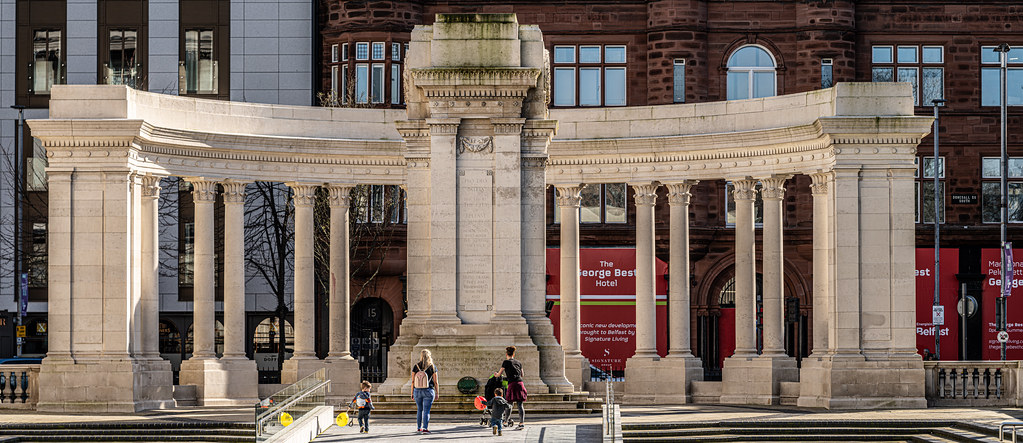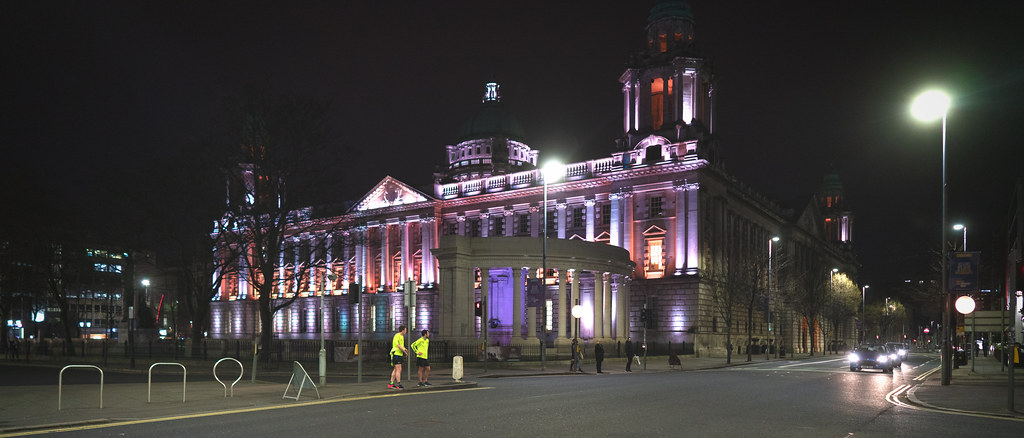BELFAST CITY HALL 2019 I LIKE THIS BUILDING
The site now occupied by Belfast City Hall was once the home of the White Linen Hall, an important international Linen Exchange. The street that runs from the back door of Belfast City Hall through the middle of Linen Quarter is Linen Hall Street.
Plans for the City Hall began in 1888 when Belfast was awarded city status by Queen Victoria. This was in recognition of Belfast's rapid expansion and thriving linen, rope-making, shipbuilding and engineering industries. During this period Belfast briefly overtook Dublin as the most populous city in Ireland.
Construction began in 1898 under the supervision of architect Sir Alfred Brumwell Thomas and was completed in 1906 at a cost of £369,000. Belfast Corporation, now the council, its their profits from the gas industry to pay for the construction of the Belfast City Hall. Local firms H&J Martin and WH Stephens were among the companies involved in the construction. James G. Gamble, architect, was the clerk of works.
The city hall in Durban, South Africa is almost an exact replica of Belfast's City Hall. It was built in 1910 and designed by Stanley G. Hudson, who was inspired by the Belfast design. The Port of Liverpool Building, designed by Arnold Thornley and completed in 1913, is another very close relative.
On 1 August 2006 the City Hall celebrated its centenary with a "Century of Memories" exhibition and family picnic day.
The gardens surrounding the City Hall are popular with office workers taking their lunch in the summer months, as well as tourists and teenagers gathering in their dozens to enjoy the green.
Various statues stand in the grounds, including one of Queen Victoria by Sir Thomas Brock. There is also a granite column dedicated to the American Expeditionary Force, many of whom were based in Belfast prior to D-Day.
Brock also designed the marble figure of Thane, the Titanic Memorial, in memorial to the victims of the sinking of the RMS Titanic. The ship was built in Harland and Wolff's shipyard located in the east of the city. The monument was originally located at the front gate of City Hall, at the junction of Donegall Square North and Donegall Place.
There is a memorial to Sir Edward Harland, the former head of the Harland and Wolff shipyard and Lord Mayor of Belfast from 1885 to 1886. It too was sculpted by Thomas Brock.
The grounds also house Northern Ireland's main war memorial, the Garden of Remembrance and Cenotaph, at which wreaths are laid on Remembrance Day.
James Magennis VC, the only Northern Irish recipient of the Victoria Cross during World War II, is also commemorated in the grounds. The Leading Seaman won the medal while serving in the Far East in 1945. A 6-foot-high (1.8 m) memorial to Magennis, made from Portland stone and bronze, stands in front of the City Hall. It was erected in 1999.
On 3 January 2006 Belfast City Councillors ratified a plan to erect a statue to the late Belfast footballer George Best in the grounds of the City Hall. Following approval from the Best family, the George Best Memorial Trust was created in December 2006. The trust's patron David Healy contributed £1,000 to the estimated total cost of £200,000. To date, 2019, this memorial has not be erected.
In 2008, the Imjin River Memorial was relocated here when the St Patrick's Barracks in Ballymena closed. The memorial commemorates Irish troops lost in the Battle of Chaegunghyon in January 1951 during the Korean War.
Plans for the City Hall began in 1888 when Belfast was awarded city status by Queen Victoria. This was in recognition of Belfast's rapid expansion and thriving linen, rope-making, shipbuilding and engineering industries. During this period Belfast briefly overtook Dublin as the most populous city in Ireland.
Construction began in 1898 under the supervision of architect Sir Alfred Brumwell Thomas and was completed in 1906 at a cost of £369,000. Belfast Corporation, now the council, its their profits from the gas industry to pay for the construction of the Belfast City Hall. Local firms H&J Martin and WH Stephens were among the companies involved in the construction. James G. Gamble, architect, was the clerk of works.
The city hall in Durban, South Africa is almost an exact replica of Belfast's City Hall. It was built in 1910 and designed by Stanley G. Hudson, who was inspired by the Belfast design. The Port of Liverpool Building, designed by Arnold Thornley and completed in 1913, is another very close relative.
On 1 August 2006 the City Hall celebrated its centenary with a "Century of Memories" exhibition and family picnic day.
The gardens surrounding the City Hall are popular with office workers taking their lunch in the summer months, as well as tourists and teenagers gathering in their dozens to enjoy the green.
Various statues stand in the grounds, including one of Queen Victoria by Sir Thomas Brock. There is also a granite column dedicated to the American Expeditionary Force, many of whom were based in Belfast prior to D-Day.
Brock also designed the marble figure of Thane, the Titanic Memorial, in memorial to the victims of the sinking of the RMS Titanic. The ship was built in Harland and Wolff's shipyard located in the east of the city. The monument was originally located at the front gate of City Hall, at the junction of Donegall Square North and Donegall Place.
There is a memorial to Sir Edward Harland, the former head of the Harland and Wolff shipyard and Lord Mayor of Belfast from 1885 to 1886. It too was sculpted by Thomas Brock.
The grounds also house Northern Ireland's main war memorial, the Garden of Remembrance and Cenotaph, at which wreaths are laid on Remembrance Day.
James Magennis VC, the only Northern Irish recipient of the Victoria Cross during World War II, is also commemorated in the grounds. The Leading Seaman won the medal while serving in the Far East in 1945. A 6-foot-high (1.8 m) memorial to Magennis, made from Portland stone and bronze, stands in front of the City Hall. It was erected in 1999.
On 3 January 2006 Belfast City Councillors ratified a plan to erect a statue to the late Belfast footballer George Best in the grounds of the City Hall. Following approval from the Best family, the George Best Memorial Trust was created in December 2006. The trust's patron David Healy contributed £1,000 to the estimated total cost of £200,000. To date, 2019, this memorial has not be erected.
In 2008, the Imjin River Memorial was relocated here when the St Patrick's Barracks in Ballymena closed. The memorial commemorates Irish troops lost in the Battle of Chaegunghyon in January 1951 during the Korean War.
You will find links to buy products from Amazon, Google and other partners. If you click on these links, you’ll find that the URL includes a small extra piece of text which identifies that the click came from my websites. This text is an affiliate code, and it means that I get a small percentage of the money you spend if you choose to buy that product, or, in some cases, other products from the site soon after. These affiliate links help pay the costs of producing my websites and ensure that the content is free to you.







